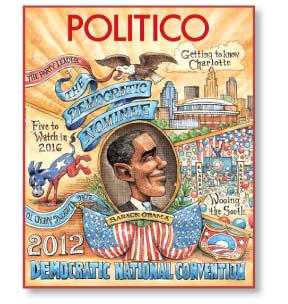The Business of Politics: Examining RNC & DNC Convention Dailies
by T.J. Raphael

POLITICO
Leveraging the Election
for Audience Growth
POLITICO distributes over 33,700 copies of its printed publication each day Congress is in session to all members of the U.S. Senate, the U.S. House of Representatives and all their Congressional staff, the White House, executive branch, Cabinet departments, federal agencies, the Supreme Court, lobbyists, special interest groups and others. To further reach its core audiences, POLITICO is embedding itself deeper into the race for political coverage by producing a convention daily.
“From a print perspective, we’re a trade publication for Capitol Hill, the White House, administration and K-Street,” says Roy Schwartz, chief revenue officer for POLITICO. “Every four years for the conventions that entire group of people goes to whichever city, or in some cases both cities, that the RNC and DNC are aligned.”
POLITICO will do six days in print for each city—August 26-31 in Tampa (RNC) and September 2-7 in Charlotte (DNC). Over 30,000 copies will be printed each day, and the brand has established a partnership with major local newspapers in the area to assist with distribution. POLITICO has produced this type of daily since its 2007 launch as a free online-only source accompanied by a print newspaper that was originally only available in Washington, D.C.
A Year-Long Lead Time
“We start planning for this about a year ahead of time,” says Schwartz. “We’ll start reaching out (to the local newspapers) on both the editorial and business sides, to make sure it works for each team. We’ll start to come to an agreement on what it will look like, and what the business arrangement will be—Tampa was done at about the end of last year and Charlotte a few months after that.”
The publication is available three days before people arrive in convention cities, and the three days through their stay. There will also be copies of POLITICO and its special 76-page, ad-supported convention guides in area airports.
“The advertiser’s primary targets are influencers on Capitol Hill, in the administration or those in Mitt Romney’s camp,” says Schwartz. “We go out to the same organizations that we work with here—we have over 500 organizations that buy advertising every year either online or in print, usually both. We contact them all to understand what their plans for the conventions are.”
Local Distribution Ties
One of the advantages of working with the local publications is “they already have the best distribution,” says Schwartz. “They already know and work with all of the hotels so you can get your product in front of all of the people when the first walk out the door. We have more copies, more days and better distribution—that’s our differentiator for our clients.”
Before the nominating event, POLITICO is raising awareness about its convention dailies by running print advertisements that alert people where they can get copies in both Tampa and Charlotte. In terms of ROI, POLITICO is hoping this will increase the number of individuals reading online since its printed edition is distributed for free in select locations in D.C. and New York, and costs $200 for a yearly subscription.
“The trade pubs in D.C. have been doing this for years,” says Schwartz. “It’s not something that’s new, but we’re new to it because we’ve only been around for five years and this is our second convention. We hope people see our coverage during the convention, which can continue to grow our traffic, which we saw last time, and we’re able to retain them post election. Once you capture them during the election, you usually retain a great number post-election as well. Since we’re a free print, we’re not looking to gain subscribers but we’re always looking to gain readers. We’ve gone through a great deal of effort to make sure we’ve got the best distribution, the largest number of print publications, the most days, the partnering and the best coverage.” ![]()